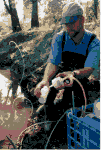The main pesticides used in the Albemarle-Pamlico Drainage Basin include alachlor, atrazine, metolachlor, carbaryl, carbofuran, and ethoprop. Recommended application rates for most pesticides range from about 0.5 pound per acre (lb/acre) to 3 lb/acre. Alachlor, the pesticide most used in the Albemarle-Pamlico Drainage Basin, is applied at rates up to 3 lb/acre, primarily in peanut cultivation. An application rate of about 1 lb/acre of many other pesticides is used for other crops grown in the study area. Some organochlorine pesticides that have long been banned from use (such as DDT) are still present in streambed sediments (see p. 18) in the basin and provide a source of these pesticides for uptake by aquatic organisms.
Of 47 pesticides and metabolites analyzed in ground-water samples from 49 wells less than 50 feet deep located across the Coastal Plain, 14 were detected. Atrazine and its metabolite, deethylatrazine, were the most commonly detected pesticides (each in 16 percent of wells sampled). Metolachlor and 2,6-diethylaniline (a formulation component of alachlor) were each detected in 10 percent of wells sampled. The remaining pesticides detected include the insecticides carbofuran, carbaryl, chlorpyrifos, diazinon, and dieldrin and the herbicides alachlor, prometon, simazine, terbacil, and tebuthiuron. Most pesticide concentrations were less than 0.1 microgram per liter (µg/L), and no pesticide concentrations detected in water from any of the 49 wells in the study area exceeded drinking-water standards or health advisory levels (although many pesticides do not have established standards). Pesticide detection rates in ground water in the agricultural areas of the Coastal Plain were among the highest nationally (p. 25). Occurrence of specific pesticides in surface and ground water is presented in the table on pages 28-33 of this report.
Of 47 pesticides analyzed in surface-water samples, 45 pesticides were detected. Four streams in the Tar River Basin had 20 or more pesticides detected, 30 streams had between 6 and 20 compounds detected, and samples from 21 streams had detectable concentrations of 1 to 5 pesticides (fig. 17). Sixteen pesticides, including four insecticides (carbaryl, carbofuran, ethoprop, and diazinon) occurred at concentrations greater than 0.1 µg/L. Generally, herbicides were detected in streams during the spring and summer months. Concentrations of several pesticides (atrazine, metolachlor) became elevated immediately after application in March and April, peaked in June and July, and finally dissipated to the detection limit or low concentrations for most of the year (fig. 18). Based on these data, drinking-water standards for pesticides are most likely to be violated during May through July.

Figure 17. Twenty or more pesticides were detected at four stream sites. Streams with the greatest number of detections of pesticide concentrations greater than 0.1 microgram per liter were in agricultural areas in the Tar River Basin.
 (767,277 bytes)
(767,277 bytes)
Pesticide application in the Contentnea Creek Basin, North Carolina
Figure 18. Atrazine, alachlor, metolachlor, and prometon concentrations in selected streams usually peaked during the principal period of herbicide application (May to June). Peaks in prometon concentration occurred in Devil's Cradle Creek from July to December.
Metolachlor was detected in 80 percent, atrazine in 69 percent, prometon in 60 percent, and alachlor in 63 percent of 233 stream samples from 65 sites in the Albemarle-Pamlico Drainage Basin. Only alachlor exceeded the drinking-water standard of 2 mg/L. Standards for drinking water or aquatic life exist for about 50 percent of the compounds detected.
 (521,524 bytes)
(521,524 bytes)
 (308,350 bytes)
(308,350 bytes)
 (658,125 bytes)
(658,125 bytes)
 (267,173 bytes)
(267,173 bytes)
The Albemarle-Pamlico NAWQA Study Unit team collecting and processing ground- and surface-water samples